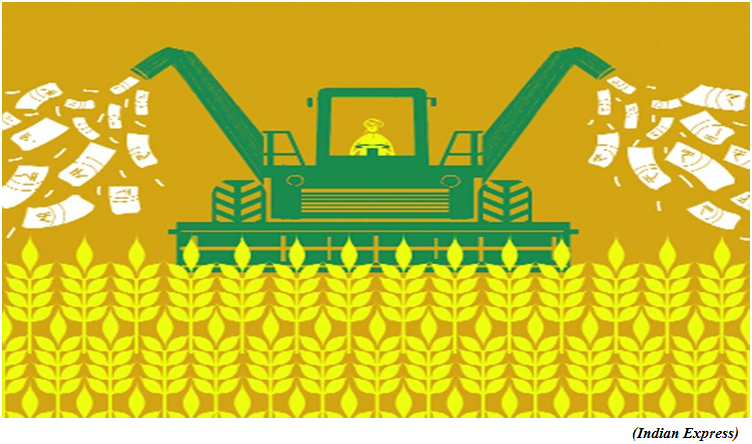Revisiting a dream (GS Paper 3, Economy)

Context:
- On February 28, 2016, Prime Minister Modi shared his dream of doubling farmers’ incomes in the year when India completes 75 years of Independence and enters Amrit Kaal.
- Now that India have entered Amrit Kaal, it is a good time to revisit that dream and see if it has been fulfilled, and if not, how best it can be done.
Why it matters?
- It was a noble dream because unless the incomes of farmers go up, India cannot have sustained high growth of overall GDP. This is because the manufacturing sector starts facing a demand constraint soon after meeting the demand of well-off urban consumers.
- After all, agriculture engages the largest share of the workforce (45.5 per cent in 2021-22 as per PLFS). So, focusing on agriculture, even if it was in a dream, is the right way to ensure long-term high growth of the overall economy.
- Agriculture also has to provide food and nutritional security to the largest population on this planet.
Sustainability:
- However, if this objective has to be achieved in today’s context, it must encompass policies that also protect the basic resources of this planet, say soil, water, air, and biodiversity.
Outcome of subsidies to farmers:
- Take the case of the fertiliser subsidy whose budget crosses Rs 2 lakh crore. Even when global prices of urea crossed $1,000/metric tonne, the Indian price of urea remained flat at around $70/tonne. This is perhaps the lowest price in the world.
- On top of this is the PM-Kisan’s Rs 60,000 crore.
- Further, many small and marginal farmers also get free ration of at least 5 kg/person/month through the PM Garib Kalyan Anna Yojana.
- There are also subsidies for crop insurance, credit and irrigation (drip).States also dole out power subsidies in abundance, especially on irrigation. Even farm machinery for custom hiring centres is being subsidised by many states.
- All this is true and the numbers of these subsidies, if combined, would easily cross Rs 4 lakh crore per annum. However, there is need to evaluate the impact of all these on farmers’ incomes and also on the environment.
- Maybe, the CAG should take up the audit of all subsidies given by the Centre and by the states to examine their outcomes in terms of the incomes of farmers and environmental consequences. The results of such an audit, if taken up, are not likely to be very palatable.
Pro-consumer approach:
- While input subsidies do help raise farmers’ incomes on one hand, there could be output trade and marketing policies adopted by the government that suppress farmers’ incomes.
- For example, the ban on exports of wheat or the 20 per cent export tax on rice, the suspension of several commodities from the futures markets, and the imposition of stocking limits on certain commodities from time to time.
- Or for that matter, unloading 2.5 MMT of wheat right now to bring down prices of wheat in mandis just before the procurement so that the government can buy at MSP, which is lower than the market price. These are hidden policy instruments of “implicit taxation” of farmers’ incomes.
- One has to net out this market support and input subsidy support to see where farmers stand. The results estimated are not showing a “pro-farmer approach”. In fact, the approach is pro-consumer. This is the fundamental problem with our policy framework.
Realigning policies:
- The policy of heavy subsidisation of input subsidies, especially fertilisers and power, along with assured and open-ended procurement of paddy and wheat at least in some selected states, is playing havoc with the environment. They are all crying out for rationalisation.
- One of the ways to move forward is to realign these support policies keeping in mind environmental outcomes.
- Millets, pulses, oilseeds, and much of horticulture could perhaps be given carbon credits to incentivise their cultivation. They consume less water and fertilisers. But if people keep getting free wheat and rice (5 kg/person/month), why will the masses adopt millets?
- We need to make subsidies/support crop-neutral. Even if they need to be skewed, they should be in favour of those crops that are benign to the planet’s basic resources.
Example of Madhya Pradesh:
- In Madhya Pradesh, one corporate is working on 100 acres to develop medicinal plants, which they have already scaled up to 5,000 acres on farmers’ fields. The lands are much poor for wheat or paddy, and farmers are readily adopting these medicinal plants as it gives them better incomes. The corporate is giving them an assured buyback arrangement to reduce their market risk.
- Another corporate is buying soybean at Rs 6,000/quintal, way above the MSP of Rs 4,300/quintal to make tofu, soya milk powder, soya ice cream, and even frozen soya yoghurt.
Way Forward:
- The bottom line is that there is need of innovations in technologies, products, institutions and policies for more diversified high-value agriculture that is also planet friendly.


